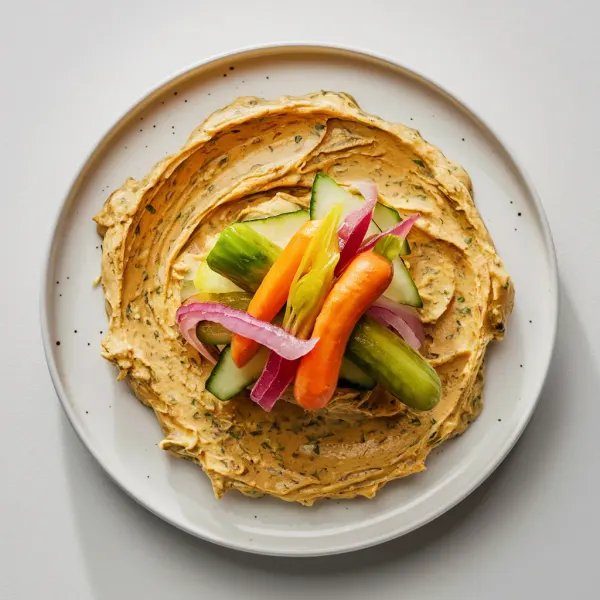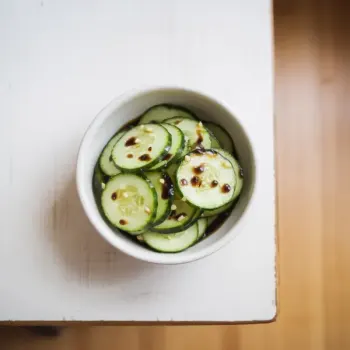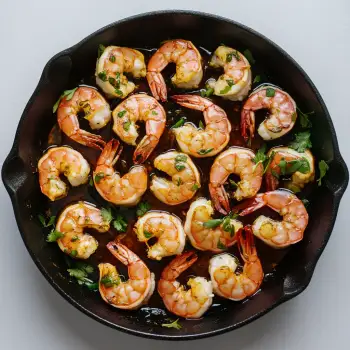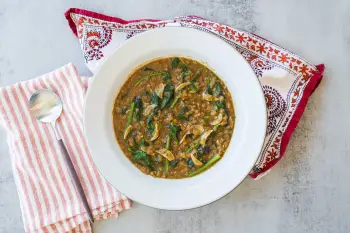
 75 minutes
75 minutesA spread that combines the tangy zing of pickled vegetables with the creamy richness of butter. Perfect for a crudité platter, a grilled cheese sandwich, or as a topper for steamed fish.

Mixed Pickled Vegetables, drained, roughly chopped
cups
Unsalted Butter, at room temperature
0 lb
1. Drain and Dry Pickled Vegetables
Start by draining your pickled vegetables well. Lay them out on paper towels and blot them gently to remove any excess moisture. This step is crucial because any leftover moisture can make your butter spread watery. You’ll know you’re done when the vegetables feel dry to the touch.
2. Chop Vegetables
Once your vegetables are well-drained, pulse them in a food processor until they are finely chopped. If you don’t have a food processor, a good knife and some patience will work just as well. The goal here is to create small, uniform pieces that will distribute evenly through the butter, ensuring each bite is packed with flavor.
3. Combine Butter and Vegetables
In a mixing bowl, take your softened unsalted butter and fold in the finely chopped vegetables. Use a wooden spoon or a rubber spatula to gently but thoroughly combine the ingredients. This step ensures that the flavor of the pickled veggies melds beautifully with the butter.
4. Transfer to Container
Transfer the mixture into your preferred serving or storage container. This can be anything from a ramekin to a small jar, depending on how you plan to use it.
5. Chill the Spread
Place the container in the refrigerator and let it chill for at least an hour. This chilling time allows the butter to firm up and the flavors to meld together. You'll know it's ready when the butter has solidified and you can see flecks of the vibrant vegetables throughout.
Combine finely chopped pickled olives, sundried tomatoes, and capers with the butter. Mix in some fresh oregano and a pinch of smoked paprika. Serve with crusty bread, use as a topping for baked fish, or stir into cooked grains like couscous or quinoa.
Swap out the pickled veggies for a blend of fresh herbs such as rosemary, thyme, basil, and oregano. Add lemon zest and a squeeze of lemon juice for a fresh, zesty flavor. This variant pairs well with grilled meats, as a base for bruschetta, or stirred into pasta.
Use pickled jalapeños or other chili peppers in place of milder pickled vegetables. Incorporate lime zest and a touch of honey to balance the heat. Great as a spread on sandwiches, burgers, or as a finishing butter for grilled corn or other vegetables.
Stir in a small amount of curry powder and turmeric into the base recipe. Add finely chopped pickled mango for a touch of sweetness. This variant can be used to sauté vegetables, as a spread for flatbreads, or to add a burst of flavor to rice dishes.
Instead of using the standard dill pickles, try different types of pickled vegetables like pickled red onions, pickled beets, or pickled carrots to introduce a new flavor profile.
Opt for a high-quality unsalted butter, preferably one that's cultured for a deeper, more nuanced flavor. Make sure it’s at room temperature for easier mixing.
Finely dice or shred your pickled vegetables to ensure they blend well with the butter without overpowering it. You want the spread to be homogenous, with each bite offering a perfect balance.
Use fresh, crisp vegetables for your pickles. The texture is as important as the taste in this spread, and fresh vegetables will provide a satisfying crunch.
Taste as you go and look for a balance between tangy, salty, and buttery. Adjust with a pinch of sugar or salt if necessary. Make it slightly stronger than you think it should be.
Once you’ve mixed your spread, let it sit in the refrigerator for at least an hour before serving. This allows the flavors to meld and the butter to firm up slightly for easier spreading.




Comments (0)